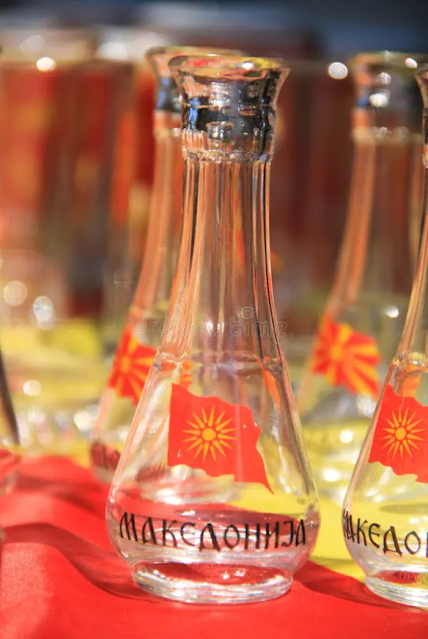One fun thing about today's cocktail culture is that consumers are exposed to new spirits and styles they may not be familiar with. Sure, one can walk up and down the aisles of Total Wine or some other place and see all sorts of unfamiliar liquids, labels emblazoned with words in foreign languages. But how many of us will buy a bottle off the wall without trying it first? Well, I will, but most of us won't.
So this is where restaurants come in, and many places that feature world cuisine are realizing there's a curiosity on the part of consumers when it comes to indigenous spirits. Onesuch "newcomer" to the wider American scene is rakia:
Rakia is a fruit brandy common in the Balkans, usually made from plums, which have a high yield and are pretty easy to grow. Because of influence of the Balkan neighbors like Austria, Hungary, and the Ottoman Empire, rakia is also made form apricots, grapes, cherries, and quince. Pretty much any fruit can be used, but those are the most common ones. Wash the fruit, pop it in a barrel and add sugar, and let it sit. If you've tried ouzo, Metaxa, Sambuca, grappa, or even Mastiha, you're in the right neighborhood in terms of texture and presentation. Typically, it's taken neat, like schnapps, and served chilled or room-temp.
If you've never heard of this, I can't blame you - it's not a common spirit here in the US...yet. Recently, I sat down virtually with Uros Jojic, director of operations for Ambar restaurant, to give us a glimpse into rakia and it's cultural connection to the Balkans.
Let's start at the beginning: rakia started, and continues, as a folk beverage. “Traditionally, everyone was making their own [rakia]. Many people produced in the home, as there were few factories." Any farm or household would have the simple equipment.
"At the end of September, after harvest when the farm work is mostly done, [people] would take some of late season fruits that are ripe and maybe starting to ferment on their own...and then distill them." So this ad-hoc distilling, essentially using "waste" fruits (not to say the fruit is bad, but maybe just leftover), was a great way to make some low-proof hooch easily. But it's not just for getting a buzz - it's part of the culture.
"Rakia is part of the social glue in the Balkans," says Uros. "Every house has some on hand, and you'd offer rakia to guests even before water." Friends would get together over a glass or four of rakia, it would be served at lunchtime, or even in the early morning. Some households that make their own may have rakia aged in wooden barrels up to 25 years, saved or the most special occasions like big social gatherings, toasting weddings, and celebrating births.
Rakia isn't moonshine and it's not some bathtub gin. Much like the US has experienced a craft distilling boom in the last decade, there are now distilleries in the Balkans region making high-quality, farm-to-table rakia. Investments in improving distilling processes, sanitation equipment like autoclaves, and scientific controls give distillers in the Balkans the ability to make high-quality rakia for export.
Speaking of - Ambar has around 30 types, if you're curious. There are plenty of "white" or clear rakia, but for those who like their rakia a bit sweeter, there are also variants dosed with cherry syrup. Ambar has a plum-based rakia that’s infused with honey, which they serve for dessert. Uros recommends sweeter rakia at the end of the meal, and the more bracing stuff before to open one's appetite before the meal.
Since cocktails are a great way to introduce US audiences to different spirits, the mixologists at Ambar are whipping up some rakia cocktails as well. Personally, I think the sweeter variants could replace liqueurs like St. Germain or any brandy in a cocktail (as opposed to, say, replacing vodka with rakia) but many rakia are nice enough to take center stage. Although mixing rakia with other stuff is not traditional, there's still room for out-of-the-box thinking.
One more thing, about one of my favorite accessories - glassware. Rakia is traditionally served in narrow glassware with a metal top. Uros notes you can use a grappa glass for the finer stuff, but the narrow glasses originally served to limit the offensive aromas coming out. Fortunately, that's changing, so grab your favorite glass and try some rakia.

